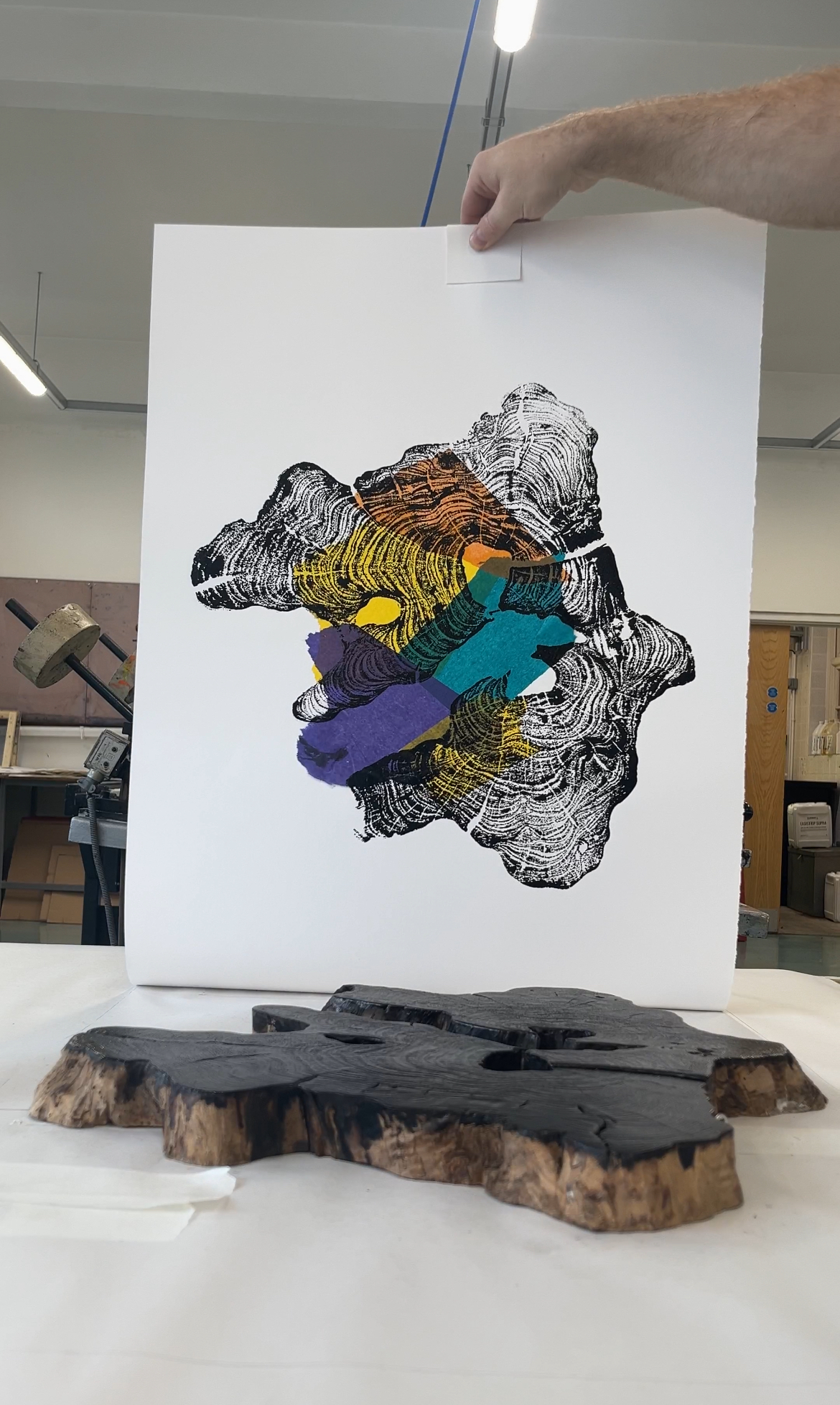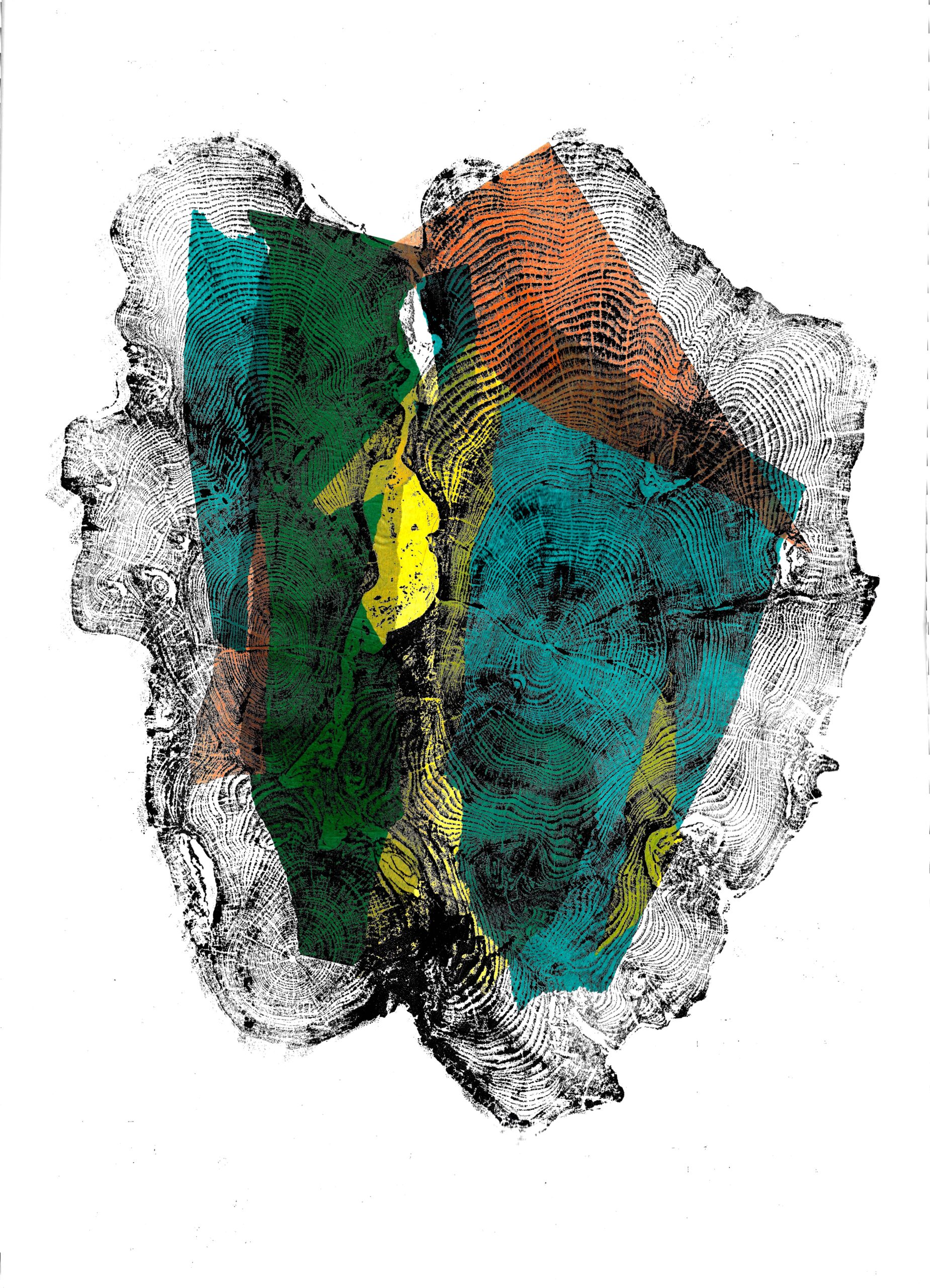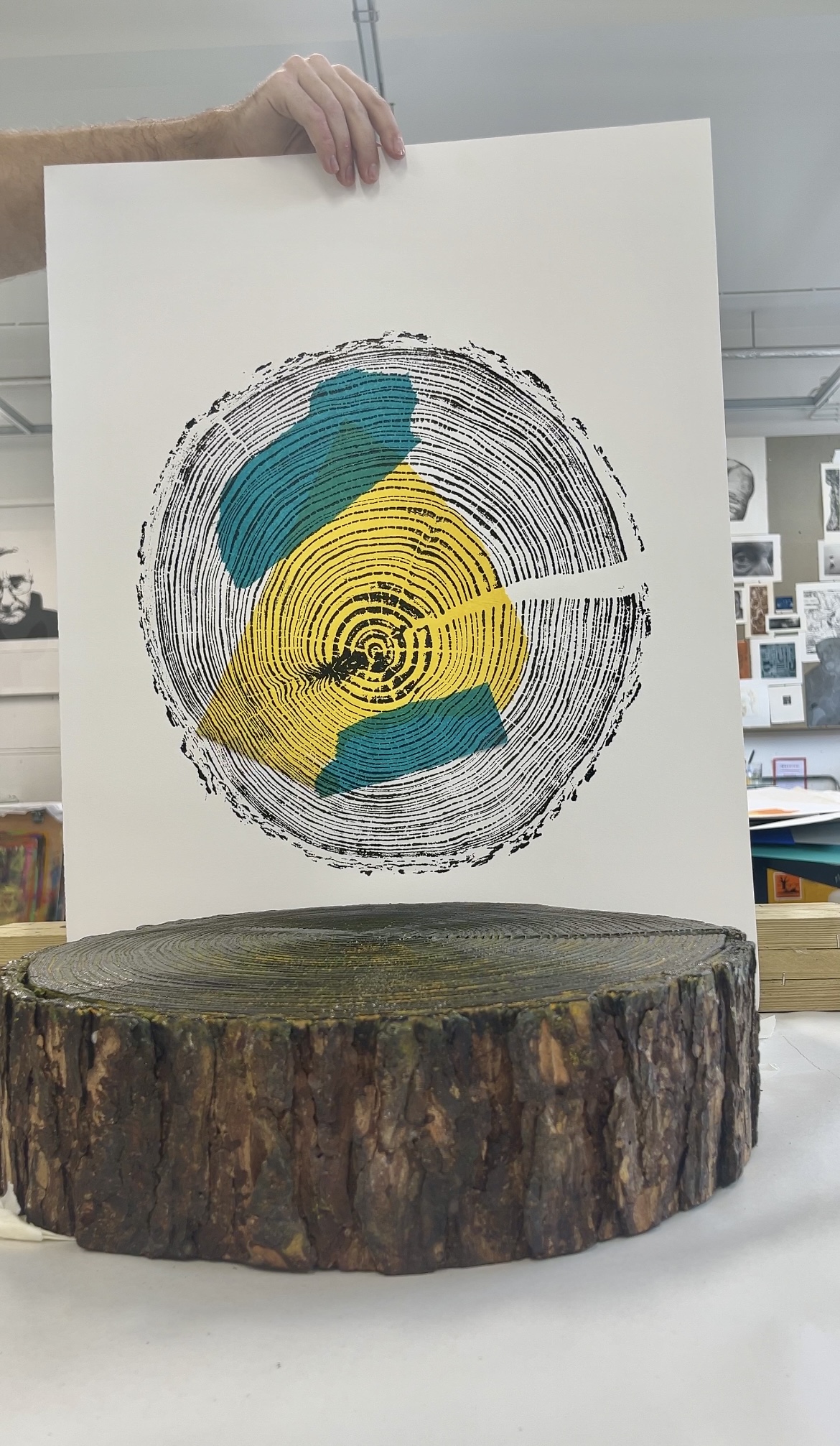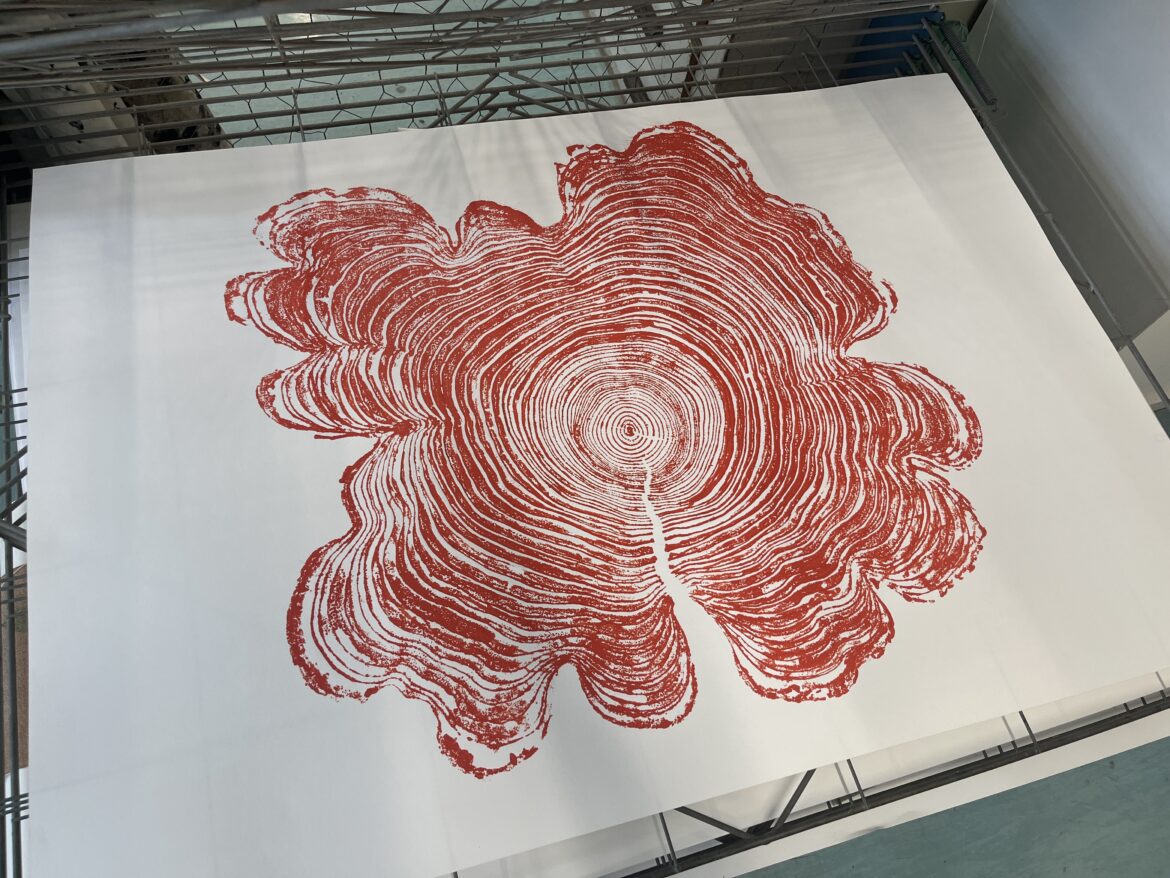Up until recent months, Swansea-based illustrator and creator of Tree Ring prints Lee Richards’ work was almost completely void of colour. “I had found that the black on white was a suitable appropriation of what my tree ring prints were capturing and recording,” says the artist. Originally, Lee had started looking at using other bolds colours, such as red, but found the result less impactful and instead had more success with using metallic colours. This led him to further experiment with Chine Collé, with the hopes of it adding to his wabi sabi (a concept centred on the acceptance of transience and imperfection) aesthetic.
 Chine Colle in the practice of using thin paper or tissue paper glued to a base paper to create a double layered surfaced print. Telling us more about his process, Lee states; “I decided that I would be quite loose and spontaneous with what tissue paper and sized pieces I would use, so that in theory it would have a more natural look to further complement the natural pre-existing tree ring prints. Each print using chine Colle is also more unique, as the process of mimicking the exact same tissue paper in size, cut and orientation is very difficult.” Lee’s use of tissue paper adds an interesting dynamic to the work, without taking attention away from the tree ring pattern itself.
Chine Colle in the practice of using thin paper or tissue paper glued to a base paper to create a double layered surfaced print. Telling us more about his process, Lee states; “I decided that I would be quite loose and spontaneous with what tissue paper and sized pieces I would use, so that in theory it would have a more natural look to further complement the natural pre-existing tree ring prints. Each print using chine Colle is also more unique, as the process of mimicking the exact same tissue paper in size, cut and orientation is very difficult.” Lee’s use of tissue paper adds an interesting dynamic to the work, without taking attention away from the tree ring pattern itself.
 “When reviewing the chine collé prints side by side I came to realise that I was having an experience of awareness towards the work on how the unseen (inside of the tree) was being shown and expressed in different ways.” To explain the awareness at first was quite difficult to translate into words, but while further exploring Japanese aesthetics, a key influence upon his work, Lee came across the concept of Yūgen.
“When reviewing the chine collé prints side by side I came to realise that I was having an experience of awareness towards the work on how the unseen (inside of the tree) was being shown and expressed in different ways.” To explain the awareness at first was quite difficult to translate into words, but while further exploring Japanese aesthetics, a key influence upon his work, Lee came across the concept of Yūgen.
Yūgen is an important part of the culture of Japanese aesthetics. The exact translation of the word depends on the context, but a rough translation provided by English writer Alan Watts states it as being the feeling of experiencing “subtle order of beauty whose origin is dark and obscure.” (Watts, 1991). It is not a feeling originating from an unfamiliar place, but a build-up of curiosity to an experience caused by the defamiliarisation of the familiarity of the tree. As Suzuki states in the book Zen and Japanese culture; “It is something we feel within ourselves, and yet it is an object about which we can talk, it is an object of mutual communication only among those who have the feeling of it.” (Suzuki and Jaffe, 2019)
In other words, the feeling experienced in relation to the object is the range of work which has a mysterious curiosity throughout it. As that curiosity grows, it results in the feeling of also wanting to get closer and touch it so that you have a feeling of the experience as well. Furthermore, the combination of seeing and touching brings further attention to the concepts that intertwine with Yūgen. One of these such concepts is Haptics.
 Haptics, in simple terms is; “impressions conveyed by the tactile and kinematic sense” (Révész, 1950). Haptic sensations rely mainly on tactile impressions rather than visual impressions as, “the haptic and visual impression of one and the same object belong to two phenomenologically different worlds of sensation.” (Révész, 1950). The main tool used in haptic sensations is the hand, which acts as a tactile organ. According to Révés, the hand is a, “universal tool of incredible accuracy and efficiency. It is endowed with unsurpassed motility and dexterity: it is a tool of the will and the spirit” (Révész, 1950).
Haptics, in simple terms is; “impressions conveyed by the tactile and kinematic sense” (Révész, 1950). Haptic sensations rely mainly on tactile impressions rather than visual impressions as, “the haptic and visual impression of one and the same object belong to two phenomenologically different worlds of sensation.” (Révész, 1950). The main tool used in haptic sensations is the hand, which acts as a tactile organ. According to Révés, the hand is a, “universal tool of incredible accuracy and efficiency. It is endowed with unsurpassed motility and dexterity: it is a tool of the will and the spirit” (Révész, 1950).
This idea of wanting to feel and get a sense of scale and texture is not only connected to Lee’s prints which have a slight brail texture to them, but is also linked to the very start of Lee’s process. Every print in the series begins with an inspection of the wood, then the surface is cleaned after burning, inked then burnished, and finally colour added with Chine Colle. These unique steps have their own tactile aesthetic which desire to be felt by touch. Lee comments; “The haptic experience allows us to feel the depth and history of the object, much like how Yūgen invites us to appreciate and view the layers of meaning in that gives us a sense of curiosity. This experimentation with chine collé eventually resulted in me going full circle and exploring different colours again. However, this time with the idea of using colours inspired by nature to complement the origin of each unique tree.”
The colour palette so far includes deep greens, earthy terracotta, and mild grey blue. The results have shown how the pattern of each tree grains appearance and presence can change, for example; from a striking figure, to a welcoming sensation, or a mysterious entity. “This transition in change of colour reminded me of how trees in their natural form go through constant change as well. Such as change in colours during different seasons. In a way a metaphorical example of transition between renewal and rebirth,” describes Lee.
 The tactile experience of creating the series also led Lee to the the concept of impermanence. Impermanence is part of Buddhist doctrine that says everything changes, and nothing stays the same, and is another important part of Japanese aesthetics. When we touch an object, we are reminded of its temporal existence—its eventual wear, decay, and return to nature. The textures we feel under our fingertips change with time, symbolising the inevitable passage of time. Lee states; “Yūgen, combined with haptics, becomes a powerful medium through which we can experience the impermanent nature of the prints”. He continues; “Furthermore, the printing process of using different types of trees, combined with chine collé and different colours has resulted in a direction of endless possibilities that appear when one appreciates the potential of using inspiration from nature itself to show its ephemeral impermanence captured inside the prints.”
The tactile experience of creating the series also led Lee to the the concept of impermanence. Impermanence is part of Buddhist doctrine that says everything changes, and nothing stays the same, and is another important part of Japanese aesthetics. When we touch an object, we are reminded of its temporal existence—its eventual wear, decay, and return to nature. The textures we feel under our fingertips change with time, symbolising the inevitable passage of time. Lee states; “Yūgen, combined with haptics, becomes a powerful medium through which we can experience the impermanent nature of the prints”. He continues; “Furthermore, the printing process of using different types of trees, combined with chine collé and different colours has resulted in a direction of endless possibilities that appear when one appreciates the potential of using inspiration from nature itself to show its ephemeral impermanence captured inside the prints.”
The idea of impermanence also links closely to the wabi sabi aesthetic. Through touch, we engage with the imperfect textures and forms of objects, experiencing their unique beauty. A cracked tree slice, a weathered surface, or a handmade object with imperfections becomes more beautiful through the understanding of wabi sabi. Haptics enables us to connect with these imperfections intimately, “bringing in new challenges for the mind to explore”. (Juniper, 2010). This tactile connection fosters a deeper appreciation for the object’s beauty and the passage of time it represents as, “wabi sabi art challenges us to unlearn our views of beauty and to rediscover the intimate beauty to be found in the smallest details of nature’s artistry”. (Juniper, 2010)
leerichardsillustration.com
@lee_richards_illustration
- 2027: A Year in Review by Tommy Evans - December 23, 2025
- Layers of Life: Chiara Mensa’s Habitat Series - December 23, 2025
- Zanmulgyeol (ripples) | The Living and Ghost Birds of Seoul - December 8, 2025







